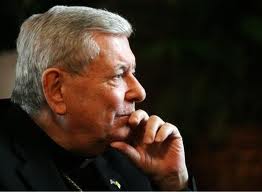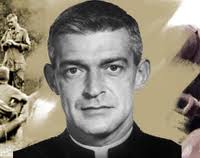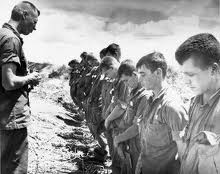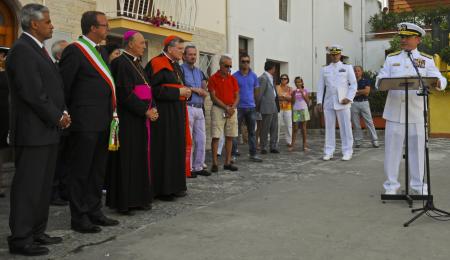Remembering Two Good Men

 Archbishop Pietro Sambi (died July 27, 2011)
Archbishop Pietro Sambi (died July 27, 2011)
Greetings after the summer vacation.
In America this summer, there was an unusual earthquake on the east coast, which I felt myself, as I was in Washington at the time, then tropical storm Irene, which uprooted trees and caused floods up and down the eastern seaboard.
So the end of the summer in America was in some way marked by natural calamities, or the threat of natural calamities. (Some people in the northeast are still without power after 11 days…)
But America’s greater difficulties today seem political, economic, cultural and moral. It is not nature which is our greatest danger, or the greatest threat to our peace and happiness.
This seemed especially true when I tried to endure watching and listening to news and opinion reports from the mainstream media in America — reports often filled with hype, sales pitches, glitz and superficiality.
Still, a bit beneath the surface, or off the beaten track, one can still find signs of grace.
The two stories I would like to touch on today are examples of such news.
(Note: I hope you find these letters useful and interesting. If you would like, please forward email addresses of others you think might like to receive these letters. Also, please note, at the end below, the news of the pilgrimages we are now offering to the Vatican itself (see end of the letter).
A Chaplain Who Died Administering the Last Rites

He died on the battlefield, shot dozens of times as he tried to administer the last rites to other dying soldiers.
 Many believe Father Capodanno displayed heroic, Christian courage at the end of his life, and should be declared a saint, and a cause has been opened for his canonization.
Many believe Father Capodanno displayed heroic, Christian courage at the end of his life, and should be declared a saint, and a cause has been opened for his canonization.
In Gaeta on September 3 — largely through the efforts of former naval officer Ted Bronson, an old friend — dozens of Americans and Italians, including Cardinal Raymond Burke of the Roman Curia, and Vice Admiral Harry B. Harris, commander of the US 6th Fleet in the Mediterranean, came together to recall Father Capodanno’s life, and his heroic, tragic, holy death.
 (Above, Vice Adm. Harry B. Harris Jr., commander, U.S. 6th Fleet, speaks to guests at a wreath-laying ceremony for Medal of Honor recipient Lt. Vincent Capodanno, a Navy chaplain, at Piazza Capodanno in Gaeta, Italy, on September 3. Capodanno was killed on a battlefield in Vietnam on September 4, 1967, as he gave physical and spiritual assistance to the dying Marines of the 1st Marine Division. Capodanno was posthumously awarded the Medal of Honor. Left to right: US Ambassador to the Holy See Miguel Diaz; the Mayor of Gaeta; the Archbishop of Gaeta Bernardo D’Onorio, OSB; His Eminence Cardinal Raymond Burke — U.S. Navy photo by Petty Officer 2nd Class Stephen Oleksiak)
(Above, Vice Adm. Harry B. Harris Jr., commander, U.S. 6th Fleet, speaks to guests at a wreath-laying ceremony for Medal of Honor recipient Lt. Vincent Capodanno, a Navy chaplain, at Piazza Capodanno in Gaeta, Italy, on September 3. Capodanno was killed on a battlefield in Vietnam on September 4, 1967, as he gave physical and spiritual assistance to the dying Marines of the 1st Marine Division. Capodanno was posthumously awarded the Medal of Honor. Left to right: US Ambassador to the Holy See Miguel Diaz; the Mayor of Gaeta; the Archbishop of Gaeta Bernardo D’Onorio, OSB; His Eminence Cardinal Raymond Burke — U.S. Navy photo by Petty Officer 2nd Class Stephen Oleksiak)
Here below are excerts from an article about Capodanno from a website devoted to his cause:
As the Marines lay dying on a Vietnamese battlefield, the Rev. Vincent Capodanno moved among them, offering comfort and rescuing them amid gunfire.
He too had been injured in the battle in 1967, his hand nearly severed and his face wounded. As he went to assist a wounded man, he was shot 27 times in the back and died, the Department of the Navy reported.
Four decades after his heroic efforts, a movement is underway to declare Capodanno, a U.S. Navy chaplain, a Catholic Saint…
Capodanno’s Cause for Canonization officially opened in May 2006 with an announcement that the Catholic Church had permitted the Archdiocese for the Military Services to proceed with the case.
The next step is beatification, according to the official Web site for the canonization of Capodanno called www.vin centcapodanno.org. For Capodanno to be declared beatified and therefore known as “Blessed Capodanno,” a medically documented physical cure solely attributed to the miraculous intercession of Vincent Robert Capodanno has to be presented and accepted by the Vatican, according to the Web site.
Born in Staten Island in 1929, Capodanno was a Maryknoll missionary who spent seven years in Taiwan and Hong Kong, later requesting and receiving permission in 1965 to join the Navy Chaplain Corps for service with the Marines in Vietnam.
Since his death on September 4, 1967, many Marines who knew him have identified their chaplain as a living saint and have presented testimonies of his bravery, compassion, and genuine holiness, his supporters said. He was known to carry hundreds of St. Christopher medals in his pockets throughout the fields of Vietnam, handing them to the Marines there.
A posthumous recipient of the Medal of Honor, Capodanno’s memorials include chapels, a boulevard, military buildings, a scholarship fund, and a frigate.
“He was a great inspiration, a great hero, a great Catholic and a great American,” Bronson said.
An Archbishop for the Gospel

A Memorial Mass in honor of the recently deceased Archbishop Pietro Sambi (photo above), papal nuncio to the United States, will be celebrated Wednesday, September 14, at noon, at the Basilica of the National Shrine of the Immaculate Conception, Washington. Archbishop Timothy M. Dolan of New York, president of the United States Conference of Catholic Bishops, will be the principal celebrant and homilist of the Memorial Mass. Over 80 bishops from around the United States will concelebrate the Mass in honor of Archbishop Sambi.
Attendance is open to the public.
There will be reserved seating for the Diplomatic Corps, Church dignitaries, and distinguished ecumenical and interreligious guests.
EWTN will televise the Mass live. Those who wish to download clips of the Mass broadcast may obtain coordinates through Jackie Hayes, the Shrine’s Director of Communications at [email protected] or 202-281-0615.
Media who wish to cover the event live should apply for credentials through [email protected].
Archbishop Sambi, a native of Italy, died July 27, at Johns Hopkins Hospital in Baltimore. His funeral was in his home town, Sogliano al Rubicone, August 2.
Here is a link to this notice: https://www.usccb.org/news/2011/11-170.cfm
And here is a link to the National Shrine’s website, with the detailas of the Shrine’s upcoming services: https://www.nationalshrine.com/site/c.osJRKVPBJnH/b.4751533/k.C897/Events/apps/nl/newsletter.asp
The Passing of a Friend: Archbishop Pietro Sambi
I knew Archbishop Sambi, and wrote my editorial for the last issue of Inside the Vatican about him. Here is the text of that editorial (from the August-September issue of Inside the Vatican magazine):
Pietro Sambi was a man with a big heart, and I was privileged to know him and call him “friend.” On July 27 in America, he passed away due to complications from surgery for a lung condition.
Born in 1938, he had just turned 73.
Sambi was the Pope’s “nuncio” to the United States, the Pope’s representative and ambassador, both to the US government and to the Catholic Church in the US, for the past five and a half years (since December 2005). His service came at a difficult time, a time of dealing with the effects of terrible sins and scandals.
He carried out all his missions with diplomatic aplomb and Italian charm. He was always willing to take time to listen, to explain, and to respond with an extraordinary warmth, good humor and spiritual depth.
The highlight of his service was in April, 2008, when he escorted Pope Benedict XVI on his visit to America.
Sambi died on the evening of July 27 at Johns Hopkins University Hospital in Baltimore due to complications from lung surgery he had undergone two weeks before. In his final hours, his sister, niece and nephew were said to be at his bedside after having been called over from Italy. The niece on hand was married by Sambi in his last trip to his beloved hometown of Rimini in mid-June.
“Archbishop Sambi understood and loved our nation,” said Archbishop Timothy Dolan of New York upon learning of Sambi’s death. “He traveled throughout the country, often to attend the ordination of bishops, always eager to meet the faithful, and to share with them the affection that the Holy Father has for them.”
“He was enormously popular,” the Rev. P. Rausch, a professor of Catholic theology at Loyola Marymount University, said. “He was very outgoing, extroverted, very positive… This man was really loved, which is not always true of those in that office.”
Sambi presided over several appointments that put Benedict’s “stamp” on the American Church. These included Dolan himself, chosen to lead the Church in New York in 2009; Archbishops Jose Gomez of Los Angeles and James Peter Sartain of Seattle in 2010; and, most recently, Archbishop Charles Chaput of Denver, who will take over the troubled Archdiocese of Philadelphia.
Sambi was born 73 years ago in Sogliano al Rubicone, in the diocese of Rimini in Italy. He was ordained priest in 1964 and entered the diplomatic service of the Holy See in 1969.

As nuncio to Israel and apostolic delegate for Palestine he worked tirelessly for Christians in the Holy Land.
Naturally therefore, messages of condolence also came from the Church in this part of the world.
“He felt a great love for the Holy Land and the Holy Land reciprocated this love,” said the Latin Patriarch of Jerusalem, Monsignor Fouad Twal. “The news of his death has saddened us enormously. We knew him and loved him.”
Father Pierbattista Pizzaballa, the Custodian of the Holy Land, described Sambi as “an honest, active man, and it may seem strange me saying this given that I am talking about an ambassador, but not a very diplomatic man. His frankness won him a lot of popularity. He was a man of great devotion and faith, who did a great deal for the Church here. He maintained his ties with the Holy Land even after he was appointed Nuncio to Washington.”
There are four memories in particular I have of him.
The first: I had invited him to give an address at a conference on Christian-Jewish relations in Washington in 2008; he had agreed. But then he received a letter from Abraham Foxman of the Jewish Anti-Defamation League expressing concern that the conference might speak of the need for the conversion of Jews to Christianity, and indicating that it might be better for Catholic-Jewish relations if Sambi did not participate. Sambi invited me to the nunciature for a conversation. In the end, Sambi agreed to attend the conference and to give the address. “Let the word ‘gratitude’ be the watchword for all of our relations with the Jews and with Judaism,” he told me. “Because it is better, and because it is true. We are grateful to the Jews. Everything we have that is most precious to us comes through them. And so we are grateful. And we should say that, always.”
The second: We were discussing the Third Secret of Fatima, the allegations that the Vatican has not published the entire text of the Third Secret as revealed to Sister Lucy, and the response of Cardinal Tarcisio Bertone, the Vatican Secretary of State, in a book where Bertone states that there is nothing more to be revealed. Sambi said, “Excuse me.” He got up, went out of the room, and came back with a book. “Here,” he said. “Do you know this book? You should read it.” It was Christopher Ferrara’s The Secret Still Hidden. “Wait,” I said. “You are the Pope’s representative in the US, and you are urging me to read a book that questions what the Secretary of State wrote?” Sambi replied: “All I am saying as that there are interesting things worth reading in this book. And in the end, we are all after the truth, aren’t we? The truth is the important thing…”
The third: when I met with him for the last time, a few months ago, I asked him for his advice on continuing to publish this magazine in an environment which is difficult for small print publications. “Go to the internet,” he told me. And so we are making plans to put our publication on the internet, without diminishing or abandoning the print edition. (Any support for this effort would be greatly appreciated. We need support for writers, editors, translators, and web masters, all of whom are willing to work for little, but all of whom need some income if we are to stay alive and compete with major journalistic operations enjoying substantial funding.)
The fourth: I once asked him about the crisis in our Church, and he said: “You have posed the question in the wrong way. It is not ‘our’ Church. It his His Church… Christ’s Church. As long as we begin from the idea that it is ‘our’ Church, we will be on the wrong path. When we understand that it is Christ’s Church, that it is He who will guide and heal and protect the Church, then we are on the right path.”
“Eternal rest grant unto him, O Lord, and let perpetual light shine upon him…”
That was the end of the editorial, but there are two more memories I have of Sambi that I would like to share.
First, he told me that the key criteria he was using to choose bishops for the US was the criteria of evangelical fervor, the ability of men to communicate to ordinary people of the present day the beauty and attractiveness of the Gospel of Christ. He said he felt he had found such men in recent years.
Second, he told me that he felt that many US bishops were closing too many churches. Though very aware of the pressures on the bishops, financially and administratively, leading them to choose to close these churches, he told me that he was urging the bishops to find new ways in order to keep as many churches open as possible.







Facebook Comments